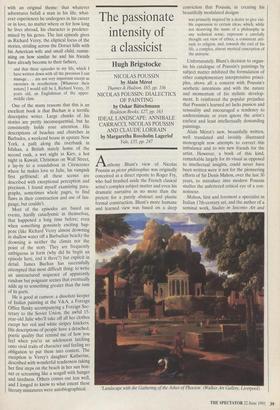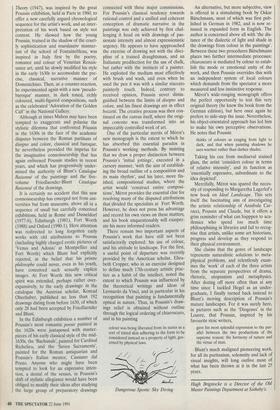The passionate intensity of a classicist
Hugh Brigstocke
Anthony Blunt's view of Nicolas Poussin as pictor philosophus was originally conceived as a direct riposte to Roger Fry, who had brushed aside the French clasical artist's complex subject matter and even his dramatic narrative as no more than the pretext for a purely abstract and plastic formal construction. Blunt's more humane and learned view was based on a deep
conviction that Poussin, in creating his beautifully modulated designs
was primarily inspired by a desire to give visi- ble expression to certain ideas, which, while not deserving the name of a philosophy in any technical sense, represent a carefully thought out view of ethics, a consistent atti- tude to religion, and, towards the end of his life, a complex, almost mystical conception of the universe.
Unfortunately, Blunt's decision to organ- ise his catalogue of Poussin's paintings by subject matter inhibited the formulation of other complementary interpretative princi- ples, above all a concern with Poussin's aesthetic intentions and with the nature and momentum of his stylistic develop- ment. It reinforced the popular prejudice that Poussin's learned art lacks passion and sensuality and encouraged a tendency to underestimate or even ignore the artist's earliest and least intellectually demanding paintings.
Alain Merot's new, beautifully written, well translated and lavishly illustrated monograph now attempts to correct this imbalance and to win new friends for the artist. However, a book of this kind, remarkable largely for its visual as opposed to intellectual insights, could never have been written were it not for the pioneering efforts of Sir Denis Mahon, over the last 30 years, to introduce into modern Poussin studies the unfettered critical eye of a con- noisseur.
Mahon, first and foremost a specialist in Italian 17th-century art, and the author of a seminal work, Studies in Seicento Art and `Landscape with the Gathering of the Ashes of Phocion' (Walker Art Gallery, Liverpool) Theory (1947), was inspired by the great Poussin exhibition, held in Paris in 1960, to offer a new carefully argued chronological sequence for the artist's work, and an inter- pretation of his work based on style not content. He showed how the young Poussin, trained in the shadow of the court- ly sophistication and retardataire manner- ism of the school of Fontainebleau, was inspired in Italy first by the poetry, romance and colour of Venetian Renais- sance art, until he slowly modified his style in the early 1630s to accomodate the pre- cise, classical, narrative manner of Domenichino. Then, as a counter-reaction, he experimented again with a new 'pseudo- baroque' manner, in dark toned, richly coloured, multi-figured compositions, such as the celebrated 'Adoration of the Golden Calf' in the National Gallery.
Although at times Mahon may have been tempted to exaggerate and polarise the stylistic dilemma that confronted POussin in the 1630s in the face of the academic disputes between the Roman partisans of disegno and colore, classical and baroque, he nevertheless provided the impetus for the imaginative connoisseurship that has again enlivened Poussin studies in recent years, and which has progressively under- mined the authority of Blunt's Catalogue Raisonne of the paintings and the five- volume Friedlaender-Blunt Catalogue Raisonne of the drawings.
It is certainly no accident that this new connoisseurship has emerged not from uni- versities but from museums, above all in a sequence of small but carefully conceived exhibitions, held in Rome and Dusseldorf (1977-8), Edinburgh (1981), Fort Worth (1988) and Oxford (1990-1). Here attention was redirected to long forgotten early works with old attributions to Poussin (including highly charged erotic pictures of `Venus and Adonis' at Montpellier and Fort Worth) which Blunt had explicitly rejected, in the belief that his peintre philosophe could never, even in his youth, have conceived such sexually explicit images. At Fort Worth this new critical spirit was extended, perhaps rather over- expansively, to the early drawings: in the catalogue the Austrian scholar, Konrad Oberhuber, published no less than 192 drawings dating from before 1630, of which only 28 had been accepted by Friedlaender and Blunt.
In the Edinburgh exhibition a number of Poussin's most romantic poesie painted in the 1620s were juxtaposed with master- pieces of his early classical style of the mid- 1630s, the `Bachanals', painted for Cardinal Richelieu, and the 'Seven Sacraments', painted for the Roman antiquarian and Poussin's Italian mentor, Cassiano dal Pozzo. Anyone who might have been tempted to look for an expressive inten- tion, a denial of the senses, in Poussin's shift of stylistic allegiance would have been obliged to modify their ideas after studying the large group of preparatory drawings connected with these major commissions. For Poussin's classical tendency towards rational control and a unified and coherent conception of dramatic narrative in the paintings was only achieved by first chal- lenging it head on with drawings of pas- sionate intensity and almost expressionistic urgency. He appears to have appproached the exercise of drawing not with the disci- pline of a trained draughtsman, and an Italianate predilection for the use of chalk, but rather with the instincts of a painter. He exploited the medium most effectively with brush and wash, and even when he used the pen it was with a similar staccato painterly touch. Indeed, contrary to received opinion, Poussin never distin- guished between the limits of disegno and colore, and his finest drawings are in effect bozzetti. The creative process was then con- tinued on the canvas itself, where the origi- nal concerto was transformed into an impeccably controlled work of art.
One of the particular merits of Merot's new monograph is the extent to which he has absorbed this essential paradox in Poussin's working methods. By insisting that we draw a proper distinction between Poussin's 'initial jottings', executed in a cursory manner, 'with the aim of establish- ing the broad outline of a composition and its main rhythm', and his later, more fin- ished, compositional studies, where the artist would 'construct entire composi- tions', Merot provides the essential clue for resolving many of the disputed attributions that divided the specialists at Fort Worth. However, he does not press his advantage and record his own views on these matters, and his book unquestionably will exasper- ate his more informed readers.
There remain two important aspects of Poussin's work that have still not been satisfactorily explored: his use of colour, and his attitude to landscape. For the first, a useful point of departure was recently provided by the American scholar, Eliza- beth Cropper, who in an exercise designed to define much 17th-century artistic prac- tice as a habit of the intellect, noted the extent to which Poussin was influenced by the theoretical writings and ideas of Leonardo da Vinci, and in particular in his recognition that painting is fundamentally optical in nature. Thus, in Poussin's draw- ings relief is obtained without outline through the logical ordering of chiaroscuro, and in his painting
colour was being liberated from its status as a sort of tinted skin adhering to the form to be considered instead as a property of light, gov- erned by physical laws.
Dangerous Sports: Sky Diving An alternative, but more subjective, view is offered in a stimulating book by Oskar Batschmann, most of which was first pub- lished in German in 1982, and is now re- issued in expanded form in English. The author is concerned above all with 'the dis- tance of the dialectic of light and shade in the drawings from colour in the paintings'. Between these two procedures Batschmann places two further intermediate processes: chiaroscuro is mediated by colour to estab- lish the mode or emotional unity of the work, and then Poussin overrides this with an independent system of local colours which demands from the spectator a more measured and less instinctive response.
Merot's wide-ranging monograph offers the perfect opportunity to test this very original theory (he knew the book from the German edition), but here once again he prefers to side-step the issue. Nevertheless, his object-orientated approach has led him to make his own perceptive observations. He notes that Poussin
thinks of colours as ranging from light to dark, and that when painting shadows he uses warmer rather than darker shades.
Taking his cue from mediaeval stained glass, the artist 'considers colour in terms of relative intensity', and its function as `essentially expressive, subordinate to the idea depicted'.
Mercifully, Merot was spared the neces- sity of responding to Margaretha Lagerlof s new book on Ideal Landscape. This sets itself the fascinating aim of investigating the artistic relationship of Annibale Car- racci, Poussin and Claude, but it offers a grim reminder of what can happpen to aca- demics who spend too much time philosophising in libraries and fail to recog- nise that artists, unlike some art historians, progress and develop as they respond to their physical environment.
She claims that the genre of landscape represents naturalistic solutions to meta- physical problems, and relentlessly exam- ines the 'work' of each of the three artists from the separate perspectives of drama, rhetoric, utopianism and metaphysics. After dozing off more often than at any time since I tackled Hegel as an under- graduate, I finally turned back instead to Blunt's moving description of Poussin's mature landscapes. For it was surely here, in pictures such as the `Diogenes' in the Louvre, that Poussin, inspired by his favourite stoic writers, gave his most splendid expression to the par- allel between the two productions of the supreme reason: the harmony of nature and the virtue of man.
Blunt's much maligned pioneering work, for all its puritanism, solemnity and lack of visual insights, will long outlive most of what has been thrown at it in the last 25 years.
Hugh Brigstocke is a Director of the Old Master Paintings Department at Sotheby's.



























































 Previous page
Previous page